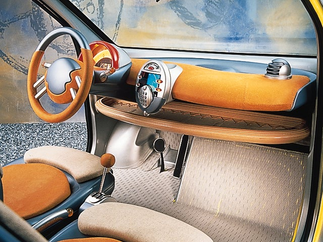1994 Mercedes-Benz MCC
- Story Cars

- Nov 16, 2021
- 3 min read
The1994 Mercedes-Benz MCC (Micro Compact Car) came in two variations: Eco-Sprinter and Eco-Speedster.

MCC Eco-Sprinter

MCC Eco-Speedster
The facts:
Vehicle: MCC (Micro Compact Car)
When: March 1994
Where: Stuttgart
What: Ultra-compact city car
Powertrain:
Eco-Sprinter: 40 kW electric motor, rear-wheel drive
Eco-Speedster: three-cylinder gasoline engine, rear-wheel drive
Innovative interior space concept with an exterior length of just 2.50 meters. Underfloor engine and transmission -> introduced 1998 in the smart city-coupe (later name: smart fortwo). Personal mobility has always been at the heart of the Mercedes-Benz vision. Gottlieb Daimler stated as much right from the start. Looking at road transport today, it is clear that Daimler's vision has become firmly established. However, what is also clear is that many towns and cities also have to contend with very heavy volumes of traffic. In the early 1980s, this prompted Mercedes-Benz to design its NAFA concept vehicle for urban and short-distance transport to use the available road space better. Measuring just 2.50 meters in length and 1.50 meters in height and width, this two-seater challenged all the conventional ideas of what a Mercedes stood for. It even had four-wheel steering, which allowed the vehicle to be driven forward into tight parking spaces. Two sliding doors provided convenient access to the interior, even when there was not much room to spare at the side. Further features included front-wheel drive, an automatic transmission, air conditioning, power steering, and belt tensioners.
Although the public soon forgot NAFA, it was not forgotten by Mercedes-Benz, which remained keenly interested in the idea of a compact city car and continued to work on one. This resulted, in 1994, in the unveiling of the compact MCC (Micro Compact Car) concept. "This is a project which combines pro-environmental design, emotion, and intelligence," said Helmut Werner, President and CEO of Mercedes-Benz AG at the time.
The MCC had its roots in NAFA; the dimensions were largely identical, but it also branched out in new directions. Fuel-efficient engines drove the rear wheels via an automatic transmission, and the concept car was also equipped with air conditioning, power steering, and belt tensioners. The designers reverted to conventional steering and doors; however, the NAFA solutions were optimal, but they would have been too elaborate and expensive for a vehicle of this size for volume production.
The two-seater interior is ideal when driving solely around town, where statistics show that the average vehicle occupancy is just 1.2 persons. The exterior length of 2.50 meters might not sound a lot. Still, in the MCC, two people enjoy a sense of spaciousness normally associated with a much larger car, and there's still plenty of room to spare for luggage and other items. On the question of safety, meanwhile, the MCC was a significant improvement over NAFA. To this day, the MCC offers unparalleled safety for a car of this size, allowing Mercedes-Benz to put an end to the prejudice that small cars are unsafe. This is achieved by the compact engine/transmission module's underfloor location, the same principle used in the Mercedes-Benz A-Class.
The MCC was extremely agile and fun to drive, not to mention that it certainly stood out from the crowd. Mercedes-Benz had come up with a clean-sheet exterior and interior design which was innovative, appealing, dynamic, and even somewhat provocative.
Two drivable versions of the Micro Compact Car were presented at the public debut in Stuttgart. The "Eco-Sprinter" was a particularly "green" machine. An electric motor delivering 40 kW of power also featured extensive use of high-quality renewable natural materials and recyclable components. The roof was fitted with solar cells, which provided power for the interior fan even when the car was parked.
The "Eco-Speedster" meanwhile had a removable roof so that with a few quick and easy adjustments, it could be transformed into an alfresco convertible. With the top-down, safety was ensured by a reinforced windshield frame and an integrated roll-over bar. A three-cylinder gasoline engine powered the Eco-Speedster.
The MCC, Mercedes-Benz's vision for a city car, is a vision no longer. By 1998 it had already gone into production as the smart city-coupe, later renamed the smart fortwo. Since then, smart production has reached almost 600,000 units. With the arrival of the roadster, the coupe, and the smart forfour models, smart has already spawned its own model family and become a mature brand.
Source: DaimlerChrysler AG

%20(4)_edited.png)
































Comments